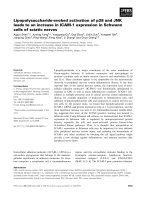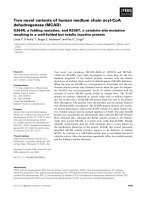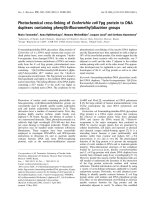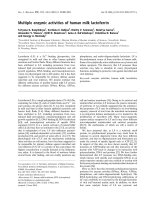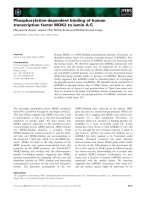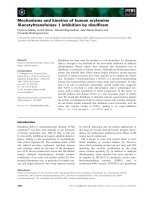Báo cáo khoa học: "Gene expression profiling of human dermal fibroblasts exposed to bleomycin sulphate does not differentiate between radiation sensitive and control patients" pptx
Bạn đang xem bản rút gọn của tài liệu. Xem và tải ngay bản đầy đủ của tài liệu tại đây (223.37 KB, 6 trang )
SHOR T REPOR T Open Access
Gene expression profiling of human dermal
fibroblasts exposed to bleomycin sulphate does
not differentiate between radiation sensitive and
control patients
Charlotte B Westbury
1,2
, Kristine Kleivi Sahlberg
3
, Anne-Lise Borresen-Dale
3,4
, Clare M Isacke
2*
and
John R Yarnold
1*
Abstract
Background: Gene expression profiling of the transcriptional response of human dermal fibroblasts to in vitro
radiation has shown promise as a predictive test of radiosensitivity. This study tested if treatment with the
radiomimetic drug bleomycin sulphate could be used to differentiate radiation sensitive patients and controls in
patients who had previously received radiotherapy for early breast cancer.
Findings: Eight patients who developed marked late radiation change assessed by photographic breast
appearance and 8 matched patients without any change were selected from women entered in a prospective
randomised trial of bre ast radiotherapy fractionation. Gene expression profiling of primary skin fibroblasts exposed
in vitro to bleomycin sulphate and mock treated fibroblast controls was performed. 973 genes were up-regulated
and 923 down-reguated in bleomycin sulphate treated compared to mock treated control fibroblasts. Gene
ontology analysis revealed enriched groups were cellular localisation, apoptosis, cell cycle and DNA damage
response for the deregulated gen es. No transcriptional differences were identified between fibroblasts from
radiation sensitive cases and control patients; subgroup analysis using cases exhibiting severe radiation sensitivity
or with high risk alleles present in TGF b1 also showed no difference.
Conclusions: The transcriptional response of human dermal fibroblasts to bleomycin sulphate has been
characterised. No differences between clinically radiation sensitive and control patients were detected using this
approach.
Introduction
Gene expression profiling of in vitro cellular responses
of human fibro blasts and l ymphocytes to radiation has
demonstrated that cells undergo complex early tran-
scriptional responses of a wide spectrum of genes from
different gene ontologies [1-4]. Microarray studies have
demonstrated that the transcriptional response of
human cells exposed to radiation in vitro differs
between radiation sensitive patients and controls.
Therefore this approac h has been explored as a predic-
tive test of radiation sensitivity using late normal tissue
effects as the endpoint of radiation sensitivity [5-7].
The spectrum of DNA damage caused by bleomycin
sulphate is similar but not identical to that caused by
ionising radiation, hence its definition as a radiomimeti c
agent [8]. The molecular and clinical responses after
bleomycin sulphate and radiation are similar: both
induce post-mitotic differ entiation of fibro blasts indu-
cing a senescent phenotype associated with increased
collagen production [9-11], activate cascades of profi-
brotic chemokines and cytokines and cause skin an d
pulmonary fibrosis in animal models and in the clinic
[12-14]. On thi s basis, the potential of using bleomycin
* Correspondence: ;
1
Department of Radiotherapy, The Royal Marsden NHS Foundation Trust &
Institute of Cancer Research, Downs Road, Sutton, Surrey, SM2 5PT, UK
2
Breakthrough Breast Cancer Research Centre, Institute of Cancer Research,
237 Fulham Road, London SW3 6JB, UK
Full list of author information is available at the end of the article
Westbury et al. Radiation Oncology 2011, 6:42
/>© 2011 Westbury et al; licens ee BioMed Central Ltd. Thi s is an Open Access article distributed under the terms of the Creative
Commons Attribution License (http ://creativecommons.org/licenses/by/2.0 ), whic h permits u nrestricted use, distribution, and
reproduction in any medium, provided the original work is properly cited.
sulphate rather than radiation for predictive testing is
here tested in an exploratory study.
Materials and methods
Patients and assessment of late normal tissue injury
Patients with a history of early breast cancer treated
with breast conserving surgery and radiotherapy within
a clinical trial of radiotherapy fractionation were
included. This patient group had prospective scoring of
late normal tissue effects [15]. Using photographic
scores, cases were identified as marked change in
appearance (grade 3) at any assessment or a persistent
moderate change (grade 2) for at least 3 consecutive
years. Controls had no or minimal change to breast
appearance (grade 1) and were matched to cases using
defined clinical parameters [see Additional File 1].
One hundred cases with radiation change and 200
matched controls with no change were selected for trans-
lational research studies. Primary dermal fibroblasts from
26/100 best matched case control pairs were prepared
from explant biopsies of buttock skin as previously
described [16]. A subset of 8 case control pairs was
selected for this study. Ethical approval was given by the
Royal Marsden NHS Foundation Trust Ethics Committee
and all patients gave written informed consent.
Cell culture and treatment with bleomycin sulphate
Fibroblasts were seeded at passage 7-9 into T75 cm
2
flasks on day 0 and cultured in DMEM/10% FCS. The
dose of bleomycin sulphate was previously determined
by cell cycle analysis using fluorescence activated cell
sorting (FACS) after treatment of fibroblasts with differ-
ent doses [see Additional File 2]. On day 1, during expo-
nential growth phase, cells were treated w ith 10 μg/ml
bleomycin sulphate or medium alone (mock control) for
6 hours. Cells were then washed in PBS and then cul-
tured in DM EM/10% FCS prior to RNA extraction on
day 4.
RNA extraction
Cells were washed once in PBS a nd lysed using the
RNeasy Mini Kit (Qiagen). Briefly, cells were lysed in
600 μl extraction buffer and samples were homogenised
by centrifugation in a QIAshredd er (Qiagen) and stored
at -80°C. For RNA isolation, 70% ethanol was added to
the sample to bind the RNA to a silica membrane filter,
impurities were removed by washing before finally elut-
ing RNA in 30 μ l water. RNA was concentrated in a
vacuum centrifuge and analysed using an Agilent 2100
Bioanalyser (Agilent Technologies).
RNA processing and hybridisation to Affymetrix chip
Biotinylated target RNA was prepared with minor modi-
fications from the manufacturer’s recommendations, on
Affymetrix />cal/manual/expression_manual.affx. Target RNA gener-
ated from each sample was then processed using an
Affymetrix GeneChip Instrument System and hybridised
to HGU133plus2 arrays. Arrays were scann ed in an
Affymetrix GeneChip Scanner 3000 system. Data pre-
processing was carried out using Affymetrix GeneChip
Operating software. The data is a vailable on MIAME-
VICE />Projects.vice.
Statistical analysis of Affymetrix data
Subsequent data processing was done using GCRMA
package in The R project (R 2.6) http://www.r-project.
org/. Data was RMA normalised and mapped to
Ensembl gene IDs by Brainarray Custom CDF http://
brainarray.mbni.med.umich.edu/Brainarray/Database/
CustomCDF/genomic_curated_CDF.asp. Absolute values
less than 50 were floored to 50. Log
2
ratios were calcu-
lated and data was median centred. Genes for which
expression values were present in less than 80% of sam-
ples were excluded. Significance Analysis of Microarrays
(SAM) [17] was performed to identify genes differen-
tially expressed between sample groups.
Gene Ontology Analysis
To identify enriched gene ontology groups, the func-
tional annotation tool on DAVID Bioinformatics
Resources 2007 was used />home.jsp. Enriched gene ontologies ranked highly
according to statistical significance were identified
(EASE score, modified Fisher exact p-value).
Results
Patient characteristics
Patient characteristics are shown in Table 1. Of the 8
radiation sensitive cases included, 3 cases had grade 3
scores of change in photographic breast appearance at
5 years i.e. marked ra diation change. The rema inder
were scored as cases with moderate change (grade 2)
for at least 3 successive years. All control patients had
grade 1 scores i.e. no/minimal change in breast
appearance.
Transcriptional response of cultured fibroblasts exposed
to bleomycin sulphate
To identify the transcriptional response of cells exposed
to bleomycin sulphate, p aired SAM o f bleomycin s ul-
phate and mock treated samples was carried out using
all 16 fibroblast cultures. Of the statistically significant
differentially expressed genes (false discovery rate = 0),
973 genes were up-regulated and 92 3 genes were down-
regulated in bleomycin sulphate treated compared to
mock treated fibroblasts [see Additional File 3].
Westbury et al. Radiation Oncology 2011, 6:42
/>Page 2 of 6
For fibroblast response to bleomycin sulphate, the
highly enriched gene ontologies for up-regulated genes
were cellular localization and cell death (Table 2) and
for down-regulated genes included regula tion of pro-
gression through cell cycle, mitotic phase of cell cycle
and DNA damage response and repair (Table 3).
Differences between radiation sensitive patients and
matched controls
SAM was used to try to identify transcriptional differ-
ences betw een fibroblasts isolated from radiation sensi-
tive patients and controls. One case control pair was
excluded from analysis as it was incorrectly matched for
radiotherapy fractionation.
Comparisons between radiation sensitive cases and
matched controls were made for mock treated fibroblast
samples (i.e. not exposed to bleomycin sulphate) and for
bleomycin sulphate treated fibroblast samples. No signif-
icant differentially expressed genes were identified in
either comparison (data not shown).
The next approach taken was to calculate fold induc-
tion in transcript levels using gene expression ratios of
log
2
values for bleomycin sulphate treated compared to
mock treated samples. Again, no significant differentially
expressed genes were identified (data not shown).
Andreassen et al. reported statistically significant asso-
ciations for 2 single nucleotide polymorphisms (SNPs)
in TGF b1 (positions -509 and codon 10) and the risk
of developing late normal tissue effects in the same
patient population [18]. Of the 7 case control pairs in
the current study, both high risk alleles were present in
5 cases and in 3 controls. The 5 cases with both high
risk alleles and 5 matched controls were selected for
further analyses. Two out of 5 of these matched controls
Table 1 Clinical characteristics of patients incorporated into analysis.
Cases Matched control pairs
Patient
number
Age Fractionation
schedule
a
Year of follow-up Patient
number
Age Fractionation
schedule
a
Year of follow-up
Dose/fraction
number
Year
1
Year
2
Year
3
Year
4
Year
5
Dose/fraction
number
Year
1
Year
2
Year
3
Year
4
Year
5
108 61 50 Gy/25 1 1 3 3 3 112 52 50 Gy/25 1 1 1 9 9
90 62 42.9 Gy/13 2 2 2 2 2 75 62 42.9 Gy/13 9 1 1 1 1
132 57 50 Gy/25 2 2 2 2 2 158 54 50 Gy/25 1 1 1 1 1
135 56 42.9 Gy/13 2 2 2 2 2 144 57 39 Gy/13 1 1 1 1 1
137 50 42.9 Gy/13 1 2 2 2 2 148 55 42.9 Gy/13 1 1 1 1 1
138 63 42.9 Gy/13 2 2 2 3 3 126 63 42.9 Gy/13 1 1 1 1 1
115 54 42.9 Gy/13 3 3 2 2 2 123 59 42.9 Gy/13 1 1 9 9 1
98 62 50 Gy/25 3 3 3 3 3 106 44 50 Gy/25 1 1 1 1 1
a
Photographic scores of breast appearance, 1, no change, 2, moderate change, 3, marked change, 9, data unavailable. 10 year data was available for control
patients 75, 126 and 106 - these scores were persistently 1. Matched cases and control pairs are presented in each line of the table.
Table 2 Enriched gene ontology terms for genes up-
regulated in bleomycin sulphate treated fibroblasts
compared to controls.
Gene ontology term
a
Number of
genes
b
EASE
score
Establishment of localization 187 1.01E-08
Localization 187 1.49E-08
Cellular physiological process 514 7.47E-08
Secretion 31 7.61E-08
Transport 169 3.11E-07
Protein transport 51 3.81E-07
Establishment of protein localization 52 4.27E-07
Protein localization 52 1.06E-06
Apoptosis 49 1.96E-06
Programmed cell death 49 2.17E-06
Cell death 50 2.52E-06
Death 50 3.04E-06
Secretory pathway 24 4.45E-06
Intracellular transport 50 7.70E-06
Establishment of cellular localization 50 1.07E-05
Cellular localization 50 1.33E-05
Regulation of apoptosis 34 1.57E-05
Intracellular protein transport 32 1.74E-05
Regulation of programmed cell
death
34 1.77E-05
Cell organization and biogenesis 98 1.81E-05
All 16 fibroblast samples were included in the analysis. The top 20 terms for
genes up-regulated after bleomycin sulphate are shown.
a
The number of genes involved in the term are shown.
b
The modified Fisher Exact p value (EASE score) is shown. The smaller the
score, the more highly enriched the category.
Westbury et al. Radiation Oncology 2011, 6:42
/>Page 3 of 6
had both high risk alleles present. SAM analysis was
performed on the 5 case control pairs using fold induc-
tion values. No significant differentially expressed genes
were identified (data not shown). Further analysis using
3 selected cases with marked radiation change and all 7
control patients also did not identify significant differen-
tially expressed genes (data not shown).
Discussion
In the current stud y, transcriptional profiling of dermal
fibroblasts after exposure to bleomycin sulphate was
carried out to determine whether differences in tran-
scriptional response could be identified between patients
with late normal tissue radiation effects and matched
controls. This w as a pilot study to determine if bleomy-
cin sulphate could be used as an alternative to radiation,
in this con text. No differences w ere detected between
the 2 patient groups. There are a number of possible
explanations for this negative finding.
In th is study, a score fo r late normal tissue effects was
performed using photographic appearance. Cases had
moderate/marked change in breast appearance and
matched controls had no/minimal change. The case
control selection may be a limitation of the current
study. Although confounding factors such as breast size
were taken into account, conventional planning techni-
ques were used in this populat ion leading to variations
in dosimetry between cases and controls. The limitation
of 5 years of follow up may have incorrectly classified
radiation sensi tive cas es into the control group in those
patients whose late normal tissue injury became mani-
fest later. However, time to development of late normal
tissue injury is a relevant parameter for judging radia-
tion sensitivity. Other than patient 112 for whom data
was missing after year 3, the available data showed no
apparent injury for 4 control patients at 5 years and for
3 control patients at 10 years after radiation (Table 1).
One of the main limitations of the study was the sam-
ple size. This and the related issue of inter-sample varia-
tion may have contributed to the negative findings. An
additional possible source of variation was that cells
were not synchronised prior to treatment. The issue of
inter-sample variation was further addressed in the
microarray analysis by using fold induction values
between drug and mock treated samples. The potential
superiority of this approach is supported in another
study of predictive testing of radiation sensitivity from
the Danish cohort of breast cancer patients [19]. In this
study, when cDNA array analysis of basal gene expres-
sion was co mpared between two pa tient groups, defined
Table 3 Enriched gene ontology terms for genes down-regulated in bleomycin sulphate treated fibroblasts compared
to controls.
Gene ontology term
a
Number of genes
b
EASE score
Cell cycle 82 6.00E-16
Mitotic cell cycle 40 4.27E-15
Mitosis 33 2.77E-14
M phase of mitotic cell cycle 33 4.09E-14
M phase 36 4.38E-13
Cell division 34 7.07E-13
DNA metabolism 72 1.36E-12
Biopolymer metabolism 196 2.85E-12
Cellular physiological process 537 2.60E-11
DNA replication 33 1.52E-10
Regulation of progression through cell cycle 53 2.42E-10
Regulation of cell cycle 53 2.65E-10
Nucleobase, nucleoside, nucleotide and nucleic acid metabolism 219 1.93E-09
Spindle organization and biogenesis 11 4.02E-09
Response to DNA damage stimulus 34 1.73E-08
Response to endogenous stimulus 35 2.45E-08
Primary metabolism 395 5.41E-08
DNA-dependent DNA replication 19 5.68E-08
DNA repair 31 6.80E-08
Macromolecule metabolism 265 1.18E-07
All 16 fibroblast samples were included in the analysis. The top 20 terms for genes down-regulated after bleomycin sulphate are shown.
a
The number of genes involved in the term are shown.
b
The modified Fisher Exact p value (EASE score) is shown. The smaller the score, the more highly enriched the category.
Westbury et al. Radiation Oncology 2011, 6:42
/>Page 4 of 6
as radiation ‘ se nsitive’ and radiation ‘ resistant’ ,only6
genes were identified as being differentially expressed,
suggesting that the difference between untreated fibro-
blasts from the two g roups is likely to be small [6]. The
authors selected 17 differentially expressed candidate
genes between the two groups, identified in ir radiated
fibroblast samples, which were further analysed by
quantitative real time polymerase chain reaction (Q-RT-
PCR) [19]. The study reported that using fold induction
values better differentiated radiation ‘ sensitive’ and
radiation ‘resistant’ patients than using either untreated
samples or radiation exposed samples alone. Fold induc-
tion takes into account background levels (i.e. the tran-
scriptional profile of untreated samples) and thereby
controls for genetic variation. However in the current
study, a difference between radiation sensitive cases and
controls was not detected even with this approach.
Bleomycin sulphate stimulates post-mitotic differentia-
tion of fibroblasts inducing a senescent or ‘post-mitotic’
phenotype associated with increased collagen production
characteristic of the terminal differentiation pathway sti-
mulated by ionising radiation [9,10,20]. In the current
study, sparse cell cultures were treated for 6 hours with
10 μ g/ml bleomycin sulphate on day 1 and analysis was
performed at 72 hours to examine the transcriptional
response of cells in the post-mitotic state. This dose of
bleomycin sulphate has been previously shown to induce
post-mitotic differentation in fibroblasts [9]. Under these
conditions, transcriptional changes of genes related to
the expression o f the differentiated phenotype, consid-
ered to be relevant to late normal tissue radiation injury,
may be seen. However the fibroblast response to bleo-
mycin s ulphate did not confirm enrichment of relevant
gene ontology categories. For example, for up-regulated
genes, the EASE score for extracellular matrix was 3.6E-
02 and for response to oxidative stress was 7.3E-02.
Published data report the dose levels of bleomycin sul-
phate required to produce cell cycle arrest but not cell
cytotoxicity. Bleomycin sulphate is known to ca use both
G1/S and G2/M arrest [21]. At high doses, extensive
double strand DNA breaks and apoptosis occur [22].
We aimed to use a dose at which post-mitotic differen-
tiation and cellular response pathways were induced but
without causing lethality with predominant death sig-
nals. Preliminary experiments carried out in this study
using FACS analysis c onfirmed that the dose applied
resulted in predominantly G2/M arrest without signifi-
cant cell death [see Additional File 2]. Using these
experimental conditions, gene expression data did
indeed show changes in leve ls of genes relevant to cell
cycle control. Cell death pathway activation was also
seen, and this may have contributed to the inability to
differentiate radiation sensitive and control groups.
In conclusion, a difference between radiation sensitive
cases and matched controls was not detected in this
population of breast cancer trial patients who had pro-
spective scoring of late normal tissue effects. This sug-
gests any difference is likely to be small or the variatio n
between patients too great to detect a difference. Limita-
tions of the clinical trial design and the exp erimental
laboratory design could have been contributory.
Additional material
Additional file 1: Details of Royal Marsden Hospital/Gloucester
Oncology Centre Breast Radiotherapy Fractionation Trial (1986-
1998) and scoring of late normal tissue effects. The table includes
details of the Royal Marsden Hospital/Gloucester Oncology Centre Breast
Radiotherapy Fractionation Trial (1986-1998), methods of assessment of
late normal tissue injury and categorisation of patients into cases with
late radiation effects and controls with minimal/none.
Additional file 2: Cell cycle analysis of adult human dermal
fibroblasts after treatment with bleomycin sulphate. Cell cycle
analysis of adult human skin fibroblasts after treatment with bleomycin
sulphate was carried out. Fibroblasts were plated at a density of 2 × 10
4
cells in a T25 cm
2
flask and treated after 1 day in culture with medium
alone (control), or with 10 μg/ml or 50 μg/ml bleomycin sulphate for 6
hours or 24 hours as indicated. After 4 days in culture, cells were stained
with propidium iodide and analysed by fluorescence activated cell
sorting (FACS); a) representative FACS profiles. b) the percentage of cells
in each phase of the cell cycle determined using the Watson Pragmatic
model. Both doses resulted in accumulation of fibroblasts with 4N-DNA
content and therefore the lower dose (10 μg/ml) was used for the
treatment of all the experimental samples.
Additional file 3: Genes differentially regulated between bleomycin
sulphate treated and mock treated fibroblasts. Paired SAM analysis of
bleomycin sulphate treated and mock treated samples was carried out
using 16 fibroblasts cultures (8 radiation sensitive cases and 8 matched
controls). 973 genes were up-reulated and 923 genes were down-
regulated in bleomycin sulphate treated compared to mock treated
fibroblasts.
Abbreviations
PBS: phosphate-buffered saline; DMEM: Dulbecco’s modi fied eagle medium;
FCS: foetal calf serum; FACS: fluorescence activated cell sorting; Q-RT-PCR:
quantitative real time polymerase chain reaction; SAM: significance analysis
of microarrays;
Acknowledgements
We thank Yvonne Hey and Stuart Pepper at the Cancer Research UK
Affymetrix Genechip Microarray Service, Paterson Institute for Cancer
Research, for performing the Affymetrix Gene Arrays and for technical
support and advice and Henrik Edgren at Institute for Molecular Medicine,
University of Helsinki, Finland for help with the Affymetrix gene
normalisation. We also thank Carsten Herskind at the Department of
Radiation Oncology, University Medical Center Mannheim, University of
Heidelberg, Germany for helping with the experimental design and Jorge
Reis-Filho and Jo Haviland at the Institute of Cancer Research for useful
discussion. This work was supported by Cancer Research UK Section of
Radiotherapy (CRUK) grant number C46/A2131 and Breakthrough Breast
Cancer, the Institute of Cancer Research, UK. We acknowledge the support
of the Cancer Research UK Affymetrix Genechip Microarray Service and NHS
funding to the NIHR Biomedical Research Centre.
Author details
1
Department of Radiotherapy, The Royal Marsden NHS Foundation Trust &
Institute of Cancer Research, Downs Road, Sutton, Surrey, SM2 5PT, UK.
Westbury et al. Radiation Oncology 2011, 6:42
/>Page 5 of 6
2
Breakthrough Breast Cancer Research Centre, Institute of Cancer Research,
237 Fulham Road, London SW3 6JB, UK.
3
Department of Genetics, Institute
for Cancer Research, Oslo University Hospital, The Norwegian Radium
Hospital, Montebello, 0310 Oslo, Norway.
4
Institute of Clinical Medicine,
University of Oslo, Norway.
Authors’ contributions
CBW participated in the study design and statistical analysis, carried out cell
and RNA preparation and drafted the manuscript. KKS participated in study
design, performed statistical analysis and helped to draft the manuscript.
ALBD particiapted in aspects of the study design and statistical analysis. JRY
was responsible for conceiving the case control design and participated in
the study design. CMI participated in the study design and study
coordination. All authors read and approved the final manuscript.
Competing interests
The authors declare that they have no competing interests.
Received: 21 February 2011 Accepted: 26 April 2011
Published: 26 April 2011
References
1. Rieger KE, Chu G: Portrait of transcriptional responses to ultraviolet and
ionizing radiation in human cells. Nucleic Acids Res 2004, 32(16):4786-4803.
2. Rodningen OK, Overgaard J, Alsner J, Hastie T, Borresen-Dale AL: Microarray
analysis of the transcriptional response to single or multiple doses of
ionizing radiation in human subcutaneous fibroblasts. Radiother Oncol
2005, 77(3):231-240.
3. Tachiiri S, Katagiri T, Tsunoda T, Oya N, Hiraoka M, Nakamura Y: Analysis of
gene-expression profiles after gamma irradiation of normal human
fibroblasts. Int J Radiat Oncol Biol Phys 2006, 64(1):272-279.
4. Zhou T, Chou JW, Simpson DA, Zhou Y, Mullen TE, Medeiros M, Bushel PR,
Paules RS, Yang X, Hurban P, et al: Profiles of global gene expression in
ionizing-radiation-damaged human diploid fibroblasts reveal
synchronization behind the G1 checkpoint in a G0-like state of
quiescence. Environ Health Perspect 2006, 114(4):553-559.
5. Quarmby S, West C, Magee B, Stewart A, Hunter R, Kumar S: Differential
expression of cytokine genes in fibroblasts derived from skin biopsies of
patients who developed minimal or severe normal tissue damage after
radiotherapy. Radiat Res 2002, 157(3):243-248.
6. Rodningen OK, Borresen-Dale AL, Alsner J, Hastie T, Overgaard J: Radiation-
induced gene expression in human subcutaneous fibroblasts is
predictive of radiation-induced fibrosis. Radiother Oncol 2008,
86(3):314-320.
7. Svensson JP, Stalpers LJ, Esveldt-van Lange RE, Franken NA, Haveman J,
Klein B, Turesson I, Vrieling H, Giphart-Gassler M: Analysis of gene
expression using gene sets discriminates cancer patients with and
without late radiation toxicity. PLoS Med 2006, 3(10):e422.
8. Povirk LF, Austin MJ: Genotoxicity of bleomycin. Mutat Res 1991,
257(2):127-143.
9. Koslowski R, Morgner J, Seidel D, Knoch KP, Kasper M: Postmitotic
differentiation of rat lung fibroblasts: induction by bleomycin and effect
on prolyl 4-hydroxylase. Exp Toxicol Pathol 2004, 55(6):481-487.
10. Robles SJ, Adami GR: Agents that cause DNA double strand breaks lead
to p16INK4a enrichment and the premature senescence of normal
fibroblasts. Oncogene 1998, 16(9):1113-1123.
11. Rodemann HP, Binder A, Burger A, Guven N, Loffler H, Bamberg M: The
underlying cellular mechanism of fibrosis. Kidney Int Suppl 1996, 54:
S32-36.
12. Cutroneo KR: Evidence for TGF-beta1 and bleomycin intracellular
signaling through autocrine regulation of Smad 3 binding to the
proximal promoter of the Smad 7 gene. J Cell Biochem 2006,
97(5):933-939.
13. Rubin P, Johnston CJ, Williams JP, McDonald S, Finkelstein JN: A perpetual
cascade of cytokines postirradiation leads to pulmonary fibrosis. Int J
Radiat Oncol Biol Phys 1995, 33(1)
:99-109.
14. Yamamoto T, Takagawa S, Katayama I, Yamazaki K, Hamazaki Y, Shinkai H,
Nishioka K: Animal model of sclerotic skin. I: Local injections of
bleomycin induce sclerotic skin mimicking scleroderma. J Invest Dermatol
1999, 112(4):456-462.
15. Yarnold J, Ashton A, Bliss J, Homewood J, Harper C, Hanson J, Haviland J,
Bentzen S, Owen R: Fractionation sensitivity and dose response of late
adverse effects in the breast after radiotherapy for early breast cancer:
long-term results of a randomised trial. Radiother Oncol 2005, 75(1):9-17.
16. Peacock J, Ashton A, Bliss J, Bush C, Eady J, Jackson C, Owen R, Regan J,
Yarnold J: Cellular radiosensitivity and complication risk after curative
radiotherapy. Radiother Oncol 2000, 55(2):173-178.
17. Tusher VG, Tibshirani R, Chu G: Significance analysis of microarrays
applied to the ionizing radiation response. Proc Natl Acad Sci USA 2001,
98(9):5116-5121.
18. Andreassen CN, Alsner J, Overgaard J, Herskind C, Haviland J, Owen R,
Homewood J, Bliss J, Yarnold J: TGFB1 polymorphisms are associated
with risk of late normal tissue complications in the breast after
radiotherapy for early breast cancer. Radiother Oncol 2005, 75(1):18-21.
19. Alsner J, Rodningen OK, Overgaard J: Differential gene expression before
and after ionizing radiation of subcutaneous fibroblasts identifies breast
cancer patients resistant to radiation-induced fibrosis. Radiother Oncol
2007, 83(3):261-266.
20. Herskind C, Johansen J, Bentzen SM, Overgaard M, Overgaard J,
Bamberg M, Rodemann HP: Fibroblast differentiation in subcutaneous
fibrosis after postmastectomy radiotherapy. Acta Oncol 2000,
39(3):383-388.
21. Kaufmann WK, Kies PE: DNA signals for G2 checkpoint response in
diploid human fibroblasts. Mutat Res 1998, 400(1-2):153-167.
22. Chen J, Stubbe J: Bleomycins: towards better therapeutics. Nat Rev Cancer
2005, 5(2):102-112.
doi:10.1186/1748-717X-6-42
Cite this article as: Westbury et al.: Gene expression profiling of human
dermal fibroblasts exposed to bleomycin sulphate does not
differentiate between radiation sensitive and control patients. Radiation
Oncology 2011 6:42.
Submit your next manuscript to BioMed Central
and take full advantage of:
• Convenient online submission
• Thorough peer review
• No space constraints or color figure charges
• Immediate publication on acceptance
• Inclusion in PubMed, CAS, Scopus and Google Scholar
• Research which is freely available for redistribution
Submit your manuscript at
www.biomedcentral.com/submit
Westbury et al. Radiation Oncology 2011, 6:42
/>Page 6 of 6



